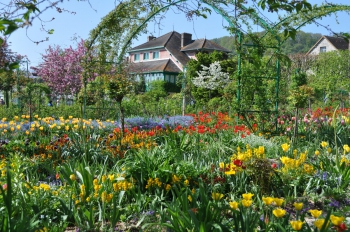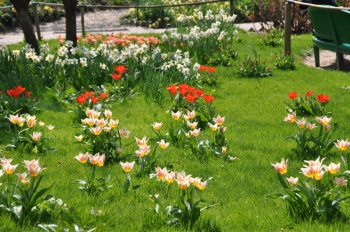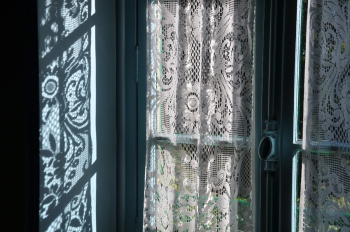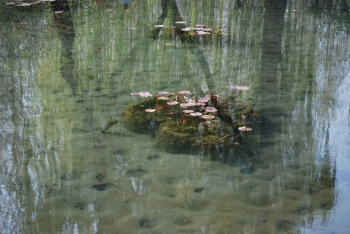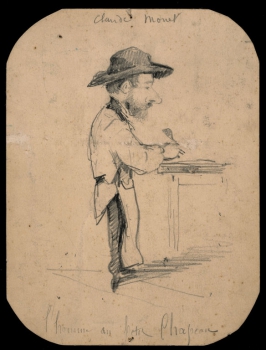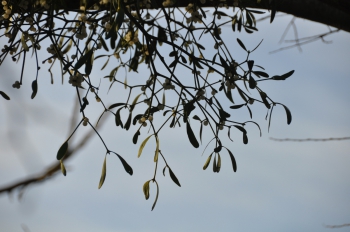Seen on a map or from the windows of his home, Monet’s flower garden aligns straight lines that ressemble almost a grid. But because Monet raised the flower beds, an oblique look through the garden doesn’t reveal the walkways. Instead, it gives the feeling of an endless flowered meadow full of striking colors. Blues are made by forget-me-not, while tulips, fritillaries and pansies provide all the colors of the painters palette. (Click on picture to enlarge)
An Invisible Pattern
April 25, 2015
This Extraordinary Spring Glow
April 11, 2015
In April, as soon as the sun shines, Monet’s garden radiates. The colors are brighter than ever. Greens are vibrant. Red tulips flame in their complementary color. All the upside down bells of the bulb flowers resemble shiny laterns that have just been switched on.
What is the reason therefore? A freshly washed air, cool enough not to contain any haze? Or is it due to the height of the sun? I don’t know. But it is properly amazing and special to early spring. The glow of April makes you want to come out in the garden, to paint and to photograph.
A Degas Exhibition in Giverny
March 29, 2015
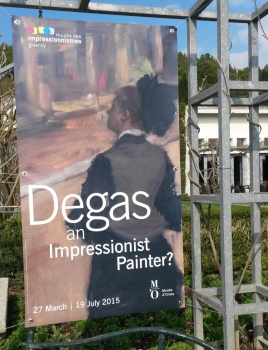 A beautiful exhibition has just started at the Museum of Impressionisms Giverny. Through 80 works signed Edgar Degas, (oil on canvas, pastel, brass, etc) it questions the painter’s membership in the group of the impressionists. His daring compositions, his motifs taking in the present day life, his free brushwork, last but not least his involvement in the organization of the impressionist exhibitions of the times make him an impressionist.
A beautiful exhibition has just started at the Museum of Impressionisms Giverny. Through 80 works signed Edgar Degas, (oil on canvas, pastel, brass, etc) it questions the painter’s membership in the group of the impressionists. His daring compositions, his motifs taking in the present day life, his free brushwork, last but not least his involvement in the organization of the impressionist exhibitions of the times make him an impressionist.
But Degas rejected open air painting, had a classical training, and hated the word impressionist itself. So was he, or not, an impressionist painter? Make your own opinion exploring this outstanding exhibition that displays many famous masterpieces, as well as less known works uncluding rarely seen Degas landscapes.
MDIG, 27 March-19 July 2015 More information
Opening: 28 March 2015
March 22, 2015
Monet’s house and gardens at Giverny will open next week on Saturday, the 28th of March 2015. If you plan to explore Monet’s place that early in the season, this is more or less what you can expect. The above pic was taken last year on the 2nd of April.
It is an effect I like and that doesn’t last for a long time, daffodils making bouquets on the fresh green lawn. Their planting recalls the way the water lilies float on the surface of the pond in Monet’s water garden.
In April it is still possible to look over the rose bushes planted all around this patch of lawn. Very soon leaves pop out, the border thickens and hides the lawn behind. In the meanwhile, the daffodils will have faded, so we will be only too happy not to see them anymore…
Eranthis or Winter Aconite
March 11, 2015
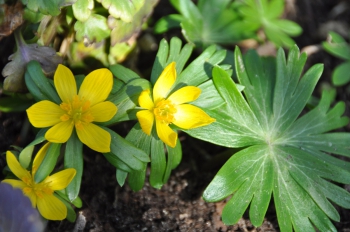 The first sunny days are warming up the soil of Giverny. In Monet’s gardens, the bravest flowers are popping out, most of them discreetly. Their bright petals make little dots of colors on the still bare ground. Pansies, snowdrops, crocuses, dwarf tulips and the first jonquils are a joy to look at. Among all these planted flowers, the eranthis impress by the carpets they make. Winter aconites are able to cover a curve of the pond bank, a nice place that will soon be shaded by tall trees.
The first sunny days are warming up the soil of Giverny. In Monet’s gardens, the bravest flowers are popping out, most of them discreetly. Their bright petals make little dots of colors on the still bare ground. Pansies, snowdrops, crocuses, dwarf tulips and the first jonquils are a joy to look at. Among all these planted flowers, the eranthis impress by the carpets they make. Winter aconites are able to cover a curve of the pond bank, a nice place that will soon be shaded by tall trees.
The eranthis is in a hurry because it needs to bloom, go to seeds and renew its food storage in its bulb in no time, that is to say before the leaves of the trees over it become too big. When the sun can’t shine through anymore, the leaves of the eranthis dry up and die. But not the plant itself! Life is stored underground, waiting patiently for three seasons to pass. Then, in February, the new shoots of eranthis appear, followed by the lovely yellow flowers in March, like miniature suns emerging from an interesting foliage. But with this plant the motto is ‘love it… and leave it alone’ because it is poisonous, just like the common aconite.
Lace Curtains
February 26, 2015
This picture was taken in one of the bedrooms of Monet’s home at Giverny. The house dates back to the mid-1800’s and most of the fixtures are still original, so I suppose this window handle is too. It is a very common model that can be seen in lots of houses of that time. Here it is painted the same pale blue as the window.
What is certainly much more recent are the curtains, although they look ancient and charming. But it is rare to find old curtains in good condition because the light and heat behind the window damage them rapidly. I suppose those were replaced at the restoration of the house in the 1970’s. They are machine made with sort of a floral pattern that resembles lace.
When I was a child I wondered. How can a curtain let us see through, but not enable people standing outside to peep in? Now I don’t any more. I take them for granted. A new surprise awaited me: I’ve realised since I work as a guide and chat with foreigners that curtains, especially lace curtains look french. Do you agree?
They also look country, in my opinion. I must confess that I am a big fan of the Country Living magazine, both the US and UK issues. It is very exciting to explore the country spirit overseas. To learn what people answer to the question ‘What makes my home country?’. Here the curtains would belong to these features. Monet’s house is at the same time a painter’s house, a house of the 19th century, the home of an upper-middle class family, and, being located in the country side, it is definitely a country house.
The Crystal Clear Pond
February 19, 2015
As long as the water is still cold, the algaes don’t feel like growing. They wait patiently for better times to come.
In March, the water of Monet’s pond is so clear that the bottom looks close, offering shamelessly all its details to the view.
The uneven surface of the layer of mud resembles the moon, with mysterious craters everywhere. The planters of water lilies pop up in this desert like a lunar buggy.
The brave first leaves have made their way through the water to reach the surface, looking for sun and energy. They are still purple but will soon turn green.
In back light, when the weather is fine, innumerable stars twinckle on the surface where the light kisses the water.
This crystal clear water is the show awaiting the first Giverny visitors. In April, days get longer, warmer, and the inviting sunbeams awake grass, flowers, trees and algaes alike.
Some years, the water looses its transparency and gets almost milky, to my delight, because I like the way it absorbs the colors, I find it lovely. After a while the water clears up again.
The Early Spring Garden
January 20, 2015
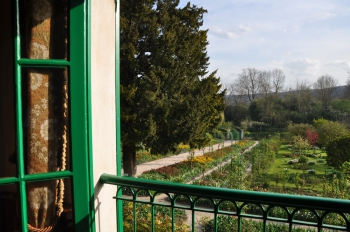 This is what Claude Monet could see when he gazed through his bedroom’s window in April. Last year spring was very early and the first colors were already there at the opening of the garden. Wallflowers make a striking effect combined with tulips, while daffodils and jonquils form islands of white and yellow flowers on the lawns. In the distance, the tall trees of the water garden don’t have any leaves yet. It is just a matter of days.
This is what Claude Monet could see when he gazed through his bedroom’s window in April. Last year spring was very early and the first colors were already there at the opening of the garden. Wallflowers make a striking effect combined with tulips, while daffodils and jonquils form islands of white and yellow flowers on the lawns. In the distance, the tall trees of the water garden don’t have any leaves yet. It is just a matter of days.
Monet is Charlie
January 12, 2015
Claude Monet, ‘L’homme au petit chapeau’ (The Man in the Small Hat) 1855/56, Art Institute of Chicago.
Monet started his career as a caricaturist. The Art Institute of Chicago keeps one of his most ancient drawings, this man in a small hat made when he was 15 years old. Because the title is so vague and the drawing rather respectful, we can imagine that this young person may have been Monet’s school mate. Later on, Monet became more offending by drawing what was not yet called the people of Le Havre, as we say in French: the upper middle class bourgeoisie of his city.
I must say this is not the Monet I like best. But it reflects the impulsive and rebellious personality of the painter. Twenty years later, it was Monet’s turn to be mocked, when he dared show his avant garde paintings at the first impressionist exhibition in Paris.
This is how liberty goes. Monet and his friends opened new fields of liberty. The freedom to paint how I like, what I like. The freedom to exhibit and find buyers.
But Monet wanted more. Later on Monet still fought for the admission of Manet’s ‘Olympia’ in the state collections. He didn’t paint for a year to dedicate to this mission. He wanted public recognition of this new freedom.
In matter of politics, Monet was not the kind of artist that withdraws in one’s studio. He was friend with Zola and supported him during the Dreyfus Affair, because he felt things were not fair and had much to do with anti-semitism.
This is how he lived, secluded in the village of Giverny but reading the newspapers, keeping an eye on the world, speaking with Clemenceau.
Monet would have been Charlie.
A Kiss Under the Mistletoe
January 4, 2015
This picture was taken on January 1st at Giverny. Outdoors, under a mistletoe plant growing on a tree. Mistletoe is extremely common in our area and can be seen on a wide range of trees including poplars, apple trees, aspens or oaks.
As long as the leaves don’t hide it, mistletoe is very visible and puzzles many visitors. It is a parasite and it does kill the branches it grows on by being too greedy, but the tree itself generally resists. In the meanwhile, mistletoe offers bed and board to many birds. It is now considered an ecological keystone species.
As a guide, I was recently asked by a client if we also kiss under the mistletoe on New Year’s Eve. Actually, we do sometimes, although I doubt this habit belongs to the French folklore. But because we love kissing in France, any excuse for it is immediately adopted, of course. However to tell the truth, the clock striking midnight is enough to start the kissing party.
I wish you many opportunities for kissing this year and twelve months full of love, friendship and warmth. Have a wonderful year 2015!
